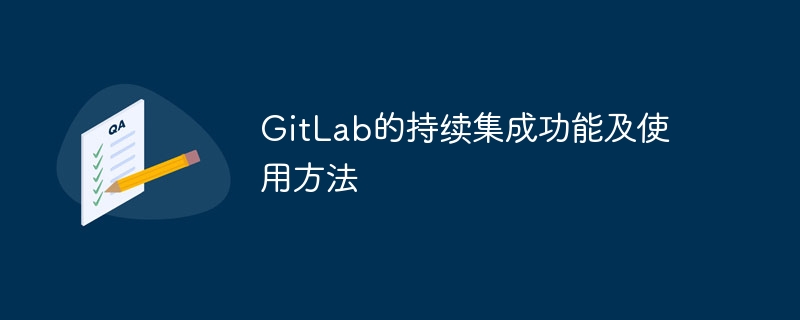Home >Development Tools >git >GitLab's continuous integration function and how to use it
GitLab's continuous integration function and how to use it
- WBOYWBOYWBOYWBOYWBOYWBOYWBOYWBOYWBOYWBOYWBOYWBOYWBOriginal
- 2023-10-20 13:54:371190browse

GitLab’s continuous integration function and usage
Overview:
In the process of software development, continuous integration (Continuous Integration, CI) is a crucial important link. It integrates developer code into the mainline more frequently and reduces potential errors and issues by automating the build, test, and deployment process. GitLab is a powerful code hosting platform that not only provides version control functions, but also integrates rich CI/CD (Continuous Integration/Continuous Deployment) functions, making continuous integration simpler and more efficient.
This article will introduce GitLab’s continuous integration function and how to use it, and give specific code examples.
1. The concept and principle of GitLab continuous integration
Continuous integration refers to integrating developer code into the main line more frequently and reducing potential errors by automating the process of building, testing and deployment. and questions.
GitLab's continuous integration is based on the GitLab CI/CD framework, which allows us to define the CI process by creating a configuration file named .gitlab-ci.yml in the project. This file defines a series of stages, tasks (jobs) and scripts (scripts), and each task will be executed in a specific stage.
2. GitLab’s continuous integration configuration file
The following is an example of a typical .gitlab-ci.yml configuration file:
stages:
- build
- test
- deploy
build:
stage: build
script:
- echo "Building..."
- make build
test:
stage: test
script:
- echo "Testing..."
- make test
deploy:
stage: deploy
script:
- echo "Deploying..."
- make deployThe above configuration file defines three stages (build, test, deploy), each stage has corresponding tasks. In each task, we can write script commands that need to be executed.
3. How to use GitLab continuous integration and examples
- Create a new project on GitLab and push the code to the warehouse.
- Create the .gitlab-ci.yml file in the project root directory and fill in the configuration information according to the above format.
- Submit the configuration file to the GitLab repository and push the code.
- Open the GitLab project page and click the CI/CD option in the left navigation bar to view the execution results of continuous integration.
Detailed demonstration:
Assume we have a simple Go language project, which uses Ginkgo as the testing framework and uses Docker for containerization:
stages:
- build
- test
build:
stage: build
script:
- echo "Building..."
- make build
test:
stage: test
script:
- echo "Testing..."
- make testIn the above In the example, we define two phases (build, test), where the build phase is used to build the project and the test phase is used to execute tests.
In the project, we can write the corresponding Makefile script to define the specific commands of build and test:
build:
go build -o myapp main.go
test:
ginkgo -rThrough the above configuration and script, we can realize the continuous integration function. When we push code to the GitLab warehouse, GitLab will automatically perform build and test operations according to the definitions in the configuration file, and generate corresponding reports and logs.
Summary:
GitLab’s continuous integration function makes it easier for us to integrate, build and test code. By properly configuring continuous integration configuration files, we can build an automated CI/CD process to improve development efficiency and code quality.
Through the introduction of this article, I believe that readers have a deeper understanding of GitLab's continuous integration function, and can practice and apply this function through specific code examples. I hope everyone can make full use of GitLab's continuous integration function in software development and improve development efficiency and code quality.
The above is the detailed content of GitLab's continuous integration function and how to use it. For more information, please follow other related articles on the PHP Chinese website!

